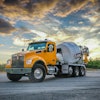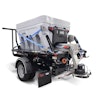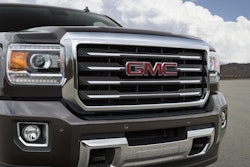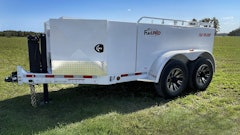
On-road diesel engine emissions regulations have been around since the early 1970s, but these standards were achieved with in-cylinder solutions that did not require extensive technological innovations. That changed when the Environmental Protection Agency (EPA) set on a path to dramatically reduce nitrogen oxide (NOx) and particulate matter (PM) almost two decades ago.
In October 1997, EPA adopted new emissions standards for model year 2004 and later heavy-duty diesel truck and bus engines. The goal was to reduce NOx emissions from on-road heavy-duty engines to levels of approximately 2.0 g/bhp-hr beginning in 2004. Since then, emissions limits have been cut to 0.01 g/bhp-hr for PM and 0.20 g/bhp-hr for NOx.
Innovations that allowed the industry to meet these emissions limits required new and often expensive technology solutions, including cooled exhaust gas recirculation, diesel particulate filters and selective catalytic reduction (SCR), just to name a few.
But just when you thought emissions restrictions had reached a technical limit, another threat to public welfare, carbon emissions, has become a target. Medium- and heavy-duty vehicles currently account for about 20% of greenhouse gas (GHG) emissions and oil use in the U.S. transportation sector, but only account for about 5% of the vehicles on the road. Globally, GHG emissions from heavy-duty vehicles are growing rapidly and are expected to surpass emissions from passenger vehicles by 2030.
The good news is that carbon emissions are directly linked to the amount of fuel consumed. Therefore, the targets set for GHG limits will result in increased fuel efficiency, which should help offset additional costs to meet the regulations.
Implementing the First Phase
The EPA and National Highway Traffic Safety Administration (NHTSA) have been working together to develop regulations and address GHG emissions at the request of President Obama. The EPA is responsible for setting emissions limits, while the NHTSA, an agency within the U.S. Department of Transportation, is tasked with developing fuel economy standards.
The Phase 1 GHG emissions and fuel-efficiency standards for medium- and heavy-duty trucks were announced in 2011 and began with model year 2014. They will be phased in through model year 2018. This impacts vehicles from semi-trucks to the largest pickups and vans, and all types and sizes of work trucks and buses in between.
For the purposes of the rule, the EPA and NHTSA define a heavy-duty fleet as all trucks with a gross vehicle weight (GVW) at or above 8,500 lbs. They estimate that Phase 1 GHG rules will save about 530 million barrels of oil over the life of vehicles built for the 2014 to 2018 model years. This reduced fuel use will allow vehicle owners to realize $50 billion in fuel savings.
But regulating fuel economy for heavy trucks is much different than setting Corporate Average Fuel Economy (CAFE) standards for passenger vehicles. There is much more diversity in the application of heavy-duty trucks. Two types of standard metrics were therefore adopted: payload-dependent gram per mile (and gallon per 100 mile) standards for pickups and vans; and gram per ton-mile (and gallon per 1,000 ton-mile) standards for vocational vehicles and combination tractors. These metrics acknowledge that moving heavier loads burns more fuel and emits more carbon dioxide than moving lighter loads.
The Phase 1 GHG standards divide heavy trucks into three main categories: combination tractors, heavy-duty pickup trucks and vans and vocational vehicles. Regulation targets will be phased in with model years 2014 through 2018.
Certain combination tractors (also known as semi-trucks) will be required to achieve an approximately 20% reduction in fuel consumption and GHG emissions by model year 2018. This would save up to 4 gal. of fuel for every 100 miles traveled.
Vocational vehicles must reduce fuel consumption and GHG emissions by approximately 10% by model year 2018. This could save an average of 1 gal. of fuel for every 100 miles traveled.
Manufacturers have indicated they are ready for the Phase 1 GHG standards 2017 certification.
“Daimler Trucks North America (DTNA) is certified to the 2017 standards,” says Sean Waters, director, product compliance and regulatory affairs, Daimler Trucks North America. “DTNA will continue to invest in technology to improve fuel efficiency in our vehicles and to improve the overall cost of ownership for our customers.”
Mack Trucks is also ready for the 2017 deadline. “While we prefer not to comment on future product plans for competitive reasons, I can tell you that Mack engines will comply with greenhouse gas requirements set to take effect in 2017,” says Curtis Dorwart, vocational products marketing manager, Mack Trucks.
Proposal for Phase 2
With Phase 1 GHG standards currently being implemented, regulators have turned their attention to Phase 2. Announced this past June, these proposed regulations would build on the success of Phase 1 standards.
The proposed Phase 2 program, which is expected to be finalized this year, would cut GHG emissions by approximately 1 billion metric tons and conserve approximately 1.8 billion barrels of oil. The standards phase in over the long term beginning in model year 2021 and culminate in standards for model year 2027.
“The proposed regulations in Phase 2 don’t just address the engine, but also the vehicle as a whole,” says Dorwart. “The EPA is still in the process of refining vocational vehicle requirements for Phase 2. Given the varied applications and configurations of vocational trucks, including a wider range of operating conditions than highway trucks, more time is needed to fully understand the impacts Phase 2 may have.”
Truck solutions will vary by application. “Fortunately, the current as well as proposed regulations for GHG recognize that there are distinct differences in duty cycle and application when it comes to vocational models compared with highway trucks,” says Dorwart. “At the current time, I see that continuing.
“In many cases, things that make a huge difference on highway trucks — like aerodynamic fairings, ground effects packages and so forth — would do little on a dump truck or refuse truck, and may in fact hinder normal operation. In short, they just are not practical,” says Dorwart.
“When it comes to engines, engine calibrations and aftertreatment systems, there will be much similarity, as is the case today,” he continues. “However, we can expect things may get more complicated depending upon how aggressive the regulations become.”
DTNA predicts that new technologies will be implemented to meet Phase 2. “The proposed Phase 2 regulation is very challenging and will have an impact on the line-haul and vocational market,” says Waters. “The vocational market in particular will require development of technology, such as stop-start, that is not currently available in the heavy-duty market.
He adds, “If regulators finalize more stringent standards than their proposed “Alternative 3”, it could create divergence from the technologies that are real-world tested and show on-road fuel-saving benefits. Anything more stringent than Alternative 3 could force technologies into applications where they are not beneficial. For example, an engine standard beyond what is currently in the proposed rule could force hybrid technology into the line-haul segment where there would be little benefit and a lot of cost.
Similar to Phase 1 regulations, the EPA’s proposed carbon dioxide emissions standards and the NHTSA’s proposed fuel consumption standards are tailored to each of four regulatory categories of heavy-duty vehicles: combination tractors, trailers pulled by combination tractors, heavy-duty pickup trucks and vans and vocational vehicles.
The biggest impact will be in combination tractors designed to haul freight. The target is to reduce carbon dioxide emissions and fuel use by 24% compared to Phase 1 standards.
The proposed new standards separate engine standards and test cycles for tractor engines, vocational diesel engines and vocational gasoline engines. For diesel engines, the proposed standards would begin in model year 2021 and phase in to model year 2027, with interim standards in model year 2024. The proposed diesel engine standards would reduce carbon dioxide emissions and fuel consumption by up to 4% compared to Phase 1. Technologies being explored include combustion optimization, improved air handling, reduced friction within the engine, improved emissions aftertreatment technologies and waste heat recovery.
Since engine technology has already squeezed out as much efficiency as possible with current technology, increased vehicle aerodynamic styling and fairings will be required for over-the-road trucks to achieve the majority of the 24% reduction. Since many vocational trucks, such as ready-mix trucks, cannot be made aerodynamic, alternative technologies are being considered to gain a 16% reduction in carbon dioxide emissions and fuel consumption relative to Phase 1.
The proposed vocational vehicle standards are differentiated using three vehicle weights and three driving cycles. The improvements are projected to come from improvements in the engine, transmission, driveline, lower rolling resistance tires, workday idle reduction technologies and weight reduction.
Trailer Regulations Reach Beyond Box Van Models
To reach its objective, proposed Phase 2 standards had to look beyond the tractors to the trailers being pulled. The design of the trailers can have a significant impact on the overall tractor-trailer vehicle.
As such, the Phase 2 standards also feature efficiency standards for new trailers. It has been determined that trailers pulled by combination tractors contribute significantly to carbon pollution emissions and to the vehicle’s fuel consumption. This can be significantly reduced with aerodynamic devices, low rolling resistance tires and automatic tire inflation systems.
Initial proposed standards for trailers would apply beginning January 1, 2018 in the EPA program. The NHTSA’s trailer standards would be voluntary from 2018 to 2020, becoming mandatory in model years 2021 and 2024. The most stringent requirements would not apply until model year 2027. Compared to conventional trailers, the fully phased-in program would result in carbon dioxide and fuel consumption reductions up to 8% for 2027 model year trailers, depending on the type of trailer.
The regulations reach beyond conventional box trailers. Non-box trailers, including platform/flatbed, container chassis and other specialty trailers, may be required to use lower rolling resistance tires and automatic tire inflation systems. Certain specialized trailers, such as logging, mining, livestock and trailers intended for temporary or permanent residence or office space (mobile homes and campers), would not be subject to the new requirements.
“Tires are fair game, but I don’t see any exotic proposals yet for trailers in vocational applications,” says Dorwart. “Tire pressure monitoring systems can add value to a fleet regardless of regulation, and tire inflation systems, as well. The agencies are considering whether to give at least partial credit to tire pressure monitoring systems.
“While neither low rolling resistance tires nor tire inflation systems will actually be required by the regulation,” he adds, “they will likely be deployed by manufacturers to comply.”
Facing the Regulatory Reality
New emissions regulations are poised to take us beyond 2027. But don’t expect the challenges to stop there. The California Air Resources Board (CARB) has already discussed possibly cutting NOx levels in California from the already trace amounts permitted by EPA 2010 limits.
“We are aware that CARB is seeking to implement lower NOx standards in California, but no earlier than 2023,” says Dorwart. “It would be a challenge to go even lower on NOx than the trace levels the industry is at now, especially if the agencies increase the stringency of the proposed engine efficiency standards.”
“DTNA cannot speak to CARB’s plans,” says Waters. “However, I can say that there is a trade-off between carbon dioxide and NOx that presents a huge technological challenge if new NOx regulations are passed. DTNA has spent billions of dollars developing technology that both improved fuel economy and reduced NOx to near-zero levels, and continues to invest in that technology. That technology is not fully deployed into the market as there are still a substantial number of vehicles in the market with pre-2010 emissions.
“It is clear that there are substantial gains to be made in terms of carbon dioxide and NOx reductions by accelerating fleet turnover,” he notes. “Further gains can be made by improving the flow of traffic on U.S. roads. Traffic congestion has a substantial impact on the environment. DTNA would encourage policy makers to look to reduce congestion, improve traffic flow and encourage fleet turnover as alternatives to lowering the NOx standard, which is already near zero.”
“The pace of regulatory change is pretty fast,” Dorwart comments. “That in and of itself is a challenge for manufacturers as well as customers to keep up with technology and the impacts that it has on operations. How severe the real-world impacts will be is yet to be determined. I think we can all be assured that change is coming and introduction of this will occur, but the industry will continue to push forward.”
“The EPA and NHTSA have proposed very challenging regulations on an aggressive timeline that will require substantial engineering effort to meet,” says Waters. “The greatest risks are that the agencies adopt what is defined in the proposal as ‘Alternative 4’, which would ramp up standards too fast and could disrupt the market. Adoption of Alternative 4 and ultra-low NOx standards are the greatest challenges to the industry.”



















